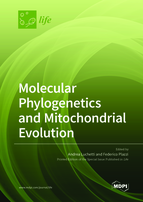Molecular Phylogenetics and Mitochondrial Evolution
A special issue of Life (ISSN 2075-1729). This special issue belongs to the section "Evolutionary Biology".
Deadline for manuscript submissions: closed (10 June 2021) | Viewed by 43796
Special Issue Editors
Interests: arthropoda; genomics; phylogenetic analysis; genetic diversity; molecular ecology; molecular evolution; molecular phylogenetics; phylogeography; DNA barcoding; hybridization; molecular taxonomy; nucleic acids; transposable elements; retrotransposons; zoology
Special Issues, Collections and Topics in MDPI journals
Interests: evolutionary biology; systematics; biodiversity; zoology; molecular biology; phylogenetic analysis; phylogenetics; genetics; sncRNA; miRNA; mitochondrial biology; bivalve molluscs; biology teaching and learning
Special Issue Information
Dear Colleagues,
Is mitochondrial phylogenetics trustworthy? In fact, mitochondrial genes are long-time phylogenetic markers: they are widely used to infer evolutionary trees across all eukaryotic realms, making cox1, rrnL, and their kin possibly the most popular genes in the world. They were initially chosen because of some key features that they were supposed to share universally.
In recent years, an increasing body of knowledge has shown several exceptions, including evidence of recombination, noncanonical ways of mitochondrial inheritance, strong selective constraints on some mitochondrial regions, and complex interactions with the nuclear genome. Conversely, massive sequencing technologies brought phylogeny into the -omics era, and the use of ESTs and transcriptomes is now common in phylogenetics, often unveiling discrepancies between the signal massively retrieved from nuclear sources and the signal carried by weird organellar chromosomes.
Although the drawbacks of mitochondrial phylogenetics have come to light and mitochondrial inferences have been questioned in front of their nuclear counterparts, the use of mitochondrial markers is nevertheless still widespread in the scientific community, and research on mitochondrial evolution, idiosyncrasies, and vagaries has emerged as a stimulating field per se. This Special Issue aims to unravel different topics on mitochondrial evolution, with special emphasis on their implications on phylogenetic reconstruction.
Prof. Dr. Andrea Luchetti
Dr. Federico Plazzi
Guest Editors
Manuscript Submission Information
Manuscripts should be submitted online at www.mdpi.com by registering and logging in to this website. Once you are registered, click here to go to the submission form. Manuscripts can be submitted until the deadline. All submissions that pass pre-check are peer-reviewed. Accepted papers will be published continuously in the journal (as soon as accepted) and will be listed together on the special issue website. Research articles, review articles as well as short communications are invited. For planned papers, a title and short abstract (about 100 words) can be sent to the Editorial Office for announcement on this website.
Submitted manuscripts should not have been published previously, nor be under consideration for publication elsewhere (except conference proceedings papers). All manuscripts are thoroughly refereed through a single-blind peer-review process. A guide for authors and other relevant information for submission of manuscripts is available on the Instructions for Authors page. Life is an international peer-reviewed open access monthly journal published by MDPI.
Please visit the Instructions for Authors page before submitting a manuscript. The Article Processing Charge (APC) for publication in this open access journal is 2600 CHF (Swiss Francs). Submitted papers should be well formatted and use good English. Authors may use MDPI's English editing service prior to publication or during author revisions.
Keywords
- mitochondrial genome
- tree reconstruction
- phylogenetics
- phylogenomics
- phylotranscriptomics
- mitochondrial evolution
- mitochondrial inheritance
- phylogenetic signal
- selective constraints








